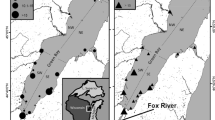Abstract
Ospreys are good indicators of the health of estuarine areas because they feed almost exclusively on fish with the balance on other aquatic biota. Through the 1980s, ospreys nesting on Delaware Bay in New Jersey had reduced reproductive success relative to those nesting on the Atlantic coast and the Maurice River, a tributary of Delaware Bay. Earlier research suggested that elevated levels of DDT and polychlorinated biphenyl (PCB) contaminants identified in addled osprey eggs contributed to this reduced productivity. We repeated egg and prey sampling initially conducted in 1989 to evaluate the trends of contaminants in the last decade. Most organochlorine contaminants declined in osprey eggs in 1998 relative to 1989. Across three study areas, PCBs decreased from 4.1–7.7 ppm in 1989 to 1.8–3.2 ppm in 1998; DDE decreased from 1.2–3.2 ppm in 1989 to 0.7–1.2 ppm in 1998. Lead in eggs increased from an average of 0.01 to 0.30 ppm wet weight, and mercury averaged 0.12 ppm and increased only in Atlantic coast eggs. Most of these contaminant changes were also found in typical prey fish: PCBs decreased from 0.18–1.2 ppm in 1989 to 0.06–0.43 ppm in 1998; DDE decreased from 0.05–0.69 ppm in 1989 to 0.03–0.13 ppm in 1998. Lead and mercury increased in most fish samples. The improvement in most organochlorine contaminants in osprey eggs and prey reflected improved nest success in the Delaware Bay study area, and the nesting populations in the Atlantic and Maurice River study areas increased approximately 200% since 1989. PCBs and DDE in osprey eggs were below levels considered to be toxic to egg development. This study documents significant improvements in organochlorine contaminants in southern New Jersey ospreys, but justifies continued monitoring of heavy metals, such as lead and mercury, in aquatic ecosystems.
Similar content being viewed by others
Author information
Authors and Affiliations
Additional information
Received: 19 April 2000/Accepted: 7 August 2000
Rights and permissions
About this article
Cite this article
Clark, K., Stansley, W. & Niles, L. Changes in Contaminant Levels in New Jersey Osprey Eggs and Prey, 1989 to 1998. Arch. Environ. Contam. Toxicol. 40, 277–284 (2001). https://doi.org/10.1007/s002440010173
Issue Date:
DOI: https://doi.org/10.1007/s002440010173




